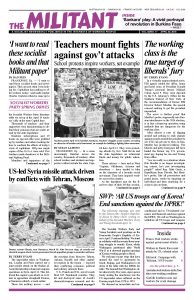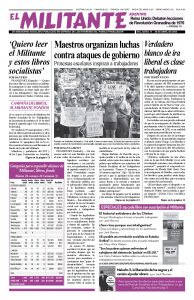We’ve done the Band-Aid,” Mike Byrne, Puerto Rico coordinator for the U.S. rulers’ Federal Emergency Management Agency, told the press in early April. “We’ve patched the [electrical] system back together.”
Some patch! At least 100,000 people are still without power and may never get it, mostly in rural towns and in mountainous areas on the island, seven months after hurricanes Irma and Maria ravaged the U.S. colony — and just two months before the start of this year’s hurricane season. On April 18 the entire electrical grid went down again when a U.S. contractor got too close to a power line with excavating equipment.
“There are tens of thousands of people without electricity, tens of thousands whose homes were destroyed that don’t qualify for aid because they don’t have official title to the land in the eyes of the bureaucracy,” Rev. Rufino Carrión said by phone from Gurabo April 17. “Some people salvaged sheets of zinc to put on a temporary roof and FEMA says they don’t qualify for help because they already have a roof!”
The electrical grid was on the verge of collapse well before the storms hit, because the colonial regime said its growing financial crisis meant it had to cut back on maintenance, lay off electrical workers and stop capital investment. The priority was to maximize payments on the government’s $74 billion debt.
‘Criminal neglect’
“This is criminal neglect and a lack of respect for the Puerto Rican people,” longtime independence fighter Rafael Cancel Miranda said by phone from San Juan April 16. “More people died from the lack of electricity, the lack of oxygen, the lack of adequate medical care than from the hurricane itself. I blame both the U.S. and the colonial government.”
The government’s official death toll from the hurricane is 64. But the New York Times reported in December that the real toll is more than 1,000, because the colonial regime doesn’t count deaths that were an indirect result of the monthslong power outages, closed health centers and the inability to refrigerate medicines like insulin.
Meanwhile, the colonial regime and the U.S. government’s Financial Oversight and Management Board for Puerto Rico continue to put the squeeze on working people to ensure payment on the debt. The board, or junta as it is known in Spanish, was appointed by President Barack Obama with the power to override any financial decision of the island’s government.
Since 2006, in the face of the worldwide economic crisis of capitalist production and trade, successive governments in Puerto Rico have slashed pensions, laid off more than 30,000 government workers, raised sales taxes and cut medical coverage. Gov. Ricardo Rosselló has accelerated the anti-working-class offensive, pushing plans to privatize the electric company, slash education, shrink the government workforce and keep cutting wages, pensions and benefits.
Education protests
The Federation of Puerto Rican Teachers is protesting government plans to close 283 schools — one-quarter of the island’s public schools — set up charter schools and issue vouchers parents can use to pay tuition at private schools. This is on top of 150 schools closed between 2010 and 2015.
“Secretary of Education Julia Keleher says she is closing schools because enrollment has gone down, with so many people moving to the U.S.,” Karla Sanabria, a teacher and member of the federation, told the Militant April 17. “She represents the rich and just looks at it like a business, a math question. In Jayuya in the mountains, where they still don’t have electricity, they’re going to close one of the most important schools.”
Even officials of the Association of Puerto Rican Teachers, which has refused to support strikes for fear of losing their official recognition as bargaining agent for teachers, are organizing “a human shield” outside the Capitol in San Juan April 25 to protest the attacks.
The Federation of Puerto Rican Teachers has been organizing daily protests by parents, students and teachers at schools across the island to build for an island-wide strike they have called for May 1, part of broader labor protests that day.
Several hundred teachers joined a national assembly coordinated by the federation and the National Union of Educators and Education Workers, Puerto Rican Educators in Action and Educamos April 15 to adopt plans to fight against the government moves.
But for wealthy bondholders and hedge fund profiteers things are looking up. “Puerto Rican bonds have been the best-performing fixed income investment thus far in 2018,” the New York Post reported April 17. Hoping to make a killing, Pacific Investment Management Co. recently added $315 million of Puerto Rico bonds to its portfolio.
“How can this be?” the Post asked, as if the paper’s capitalist owners didn’t already know. U.S. and Puerto Rican capitalists are reaping superprofits on hundreds of millions of dollars of U.S. “aid” and loans to “reconstruct” Puerto Rico, most of which will bring no lasting benefits to the Puerto Rican people. And they’re confident that when the junta certifies the Puerto Rican government’s financial “plan” April 20, payments on the debt will be the highest priority.

